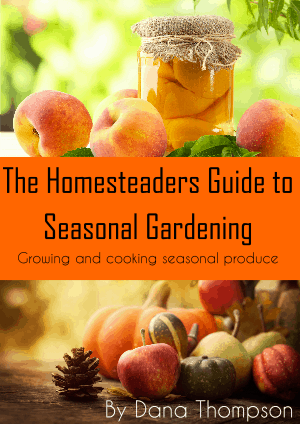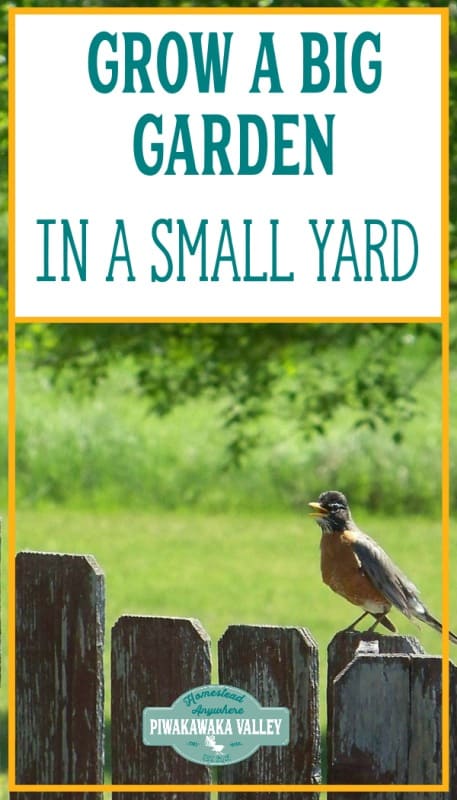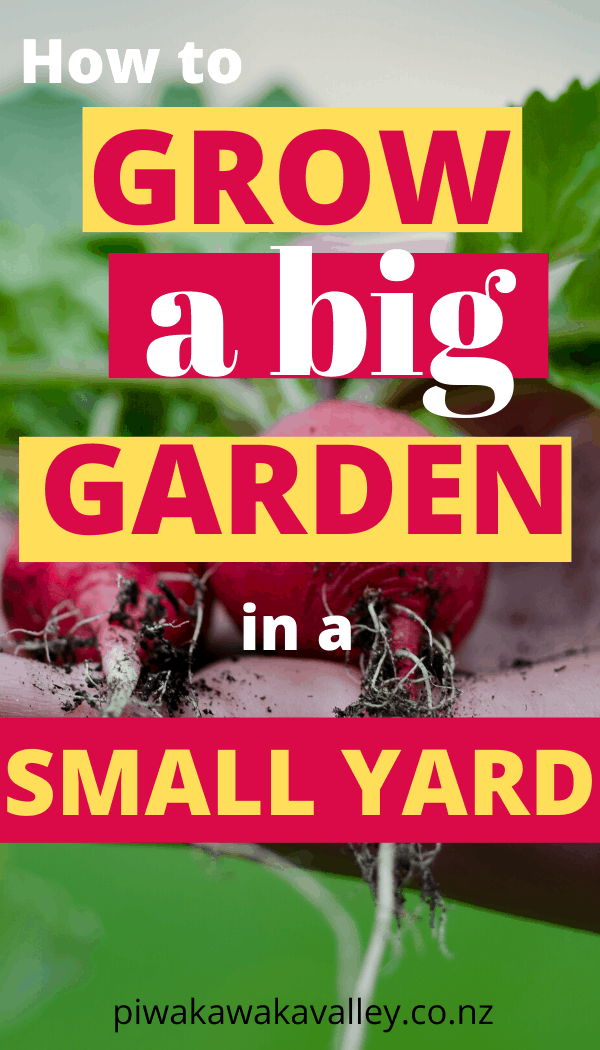This post was most recently updated on April 12th, 2023
Many people dream of having a self sufficient garden, but are put off because they don’t own lots of land. It is, however, possible to grow a self sufficient garden on a small plot of land.
Please read: This information is provided for educational purposes only and is not intended to treat, diagnose or prevent any disease. We encourage you to make your own health care decisions in partnership with a qualified health care professional.
This post contains affiliate links, this means at no extra cost to you, we make a commission from sales. Please read our Disclosure Statement
Below we are looking at different ways that you can make the most of a small garden and grow lots of food in a small back yard.
Also, if you want to move to the country and make your living doing what you love, there are ways to raise captial and involve the community so you don’t have to fund the whole thing yourself! My friends Jaymie & Shelby have done it, and they have put together a free video so you can learn to do it too. Check it out here!
Is it possible to grow a self sufficient garden in a small yard?
It is not an impossible dream to grow lots of food in a small area of garden, in fact, have you heard about the Dervaes family that live on 1/10 acre located just 15 minutes from downtown Los Angeles
They grow over 6,000 pounds (3,000kg) of food per year on their small plot of land. They grow over 400 species of plants, 4,300 pounds of vegetable food, 900 chicken and 1,000 duck eggs, 25 lbs of honey, plus seasonal fruits throughout the year.
From just 1/10th of an acre, four people manage to get over 90% of their daily food and the family reports earnings of $20,000 USD per year (AFTER they eat from what is produced).
This is all done without the use of the expensive & destructive synthetic chemicals associated with industrial mono-cropping, while simultaneously improving the fertility and overall condition of the land being used to grow this food on.
RELATED: How to improve your food security
Urban self-sufficiency: How do you grow so much food from a small property
There are some tips and tricks that you can use to help your small property grow lots of food. Some of these take time to develop, others you can start immediately.
1. Ditch the lawn
If you have a small plot of land, your growing space really is at a premium. If you just want a few vegetables you can sneak them in the flower beds.
However, if you are taking this food growing thing seriously, then it is time to seriously consider ditching the lawn and converting it to a garden too.
There are a few options you can choose from:
- Make raised beds
- Rototill up the lawn and plant directly
- Create a lasagne style bed and plant on top of the soil.
These all have their own benefits and downsides.
Raised beds
Raised beds are a great way to solve a lot of problems :
- improve drainage
- allow you to add plenty of good soil
- you can smother out weeds
- you can plant them intensively
- can have nice pathways in between
RELATED: The amazing benefits of raised beds
The only real downside to raised beds is that they cost money and time to build.
RELATED: How to prep raised beds for planting
Rototill and plant directly in the ground
The upside to this method is that you just need to hire a rototiller once and rip up the lawn.
If your soil has poor drainage, lots of weed seeds or poor fertility you will need to work on these issues as well.
Make lasagne beds
This is very easy, you need enough cardboard to cover your lawn at least one layer thick, and then buy in compost to make a 4 inch layer on the top.
The benefit to this method is that you are instantly adding nutrition, you are planting above the ground to improve drainage and the cardboard smothers out the weeds.
Spend some time on this step, thinking about bed layout, sun direction, water runoff and where you will want to walk.
RELATED: How to plan your garden
2. Grow a variety of plants
The trick with successful gardening is variety. There are several reasons to plan to grow a large variety of plants. If you are planning on eating out of your own garden as much as possible, you will want a large range of foods to choose from, living off lettuce and carrots is going to get boring pretty quickly.
The seasons are not consistent. One year you might get a late frost, or an early one, you might get a month of late rain or a scorching summer. Growing a large variety of plants helps to hedge your bets about what is and what isn’t going to grow well.
It might have been a terrible year for beans (they like the warmth) but a brilliant year for kale and peas that prefer the cold. Or visa versa.
Seed is CHEAP, grow a range of plants to help ensure you get something to work.
RELATED: What is your USDA zone
3. Plant more of what grows
This is KEY. Find out what grows well in your area and focus on those plants. There is NO POINT in me allocating an entire garden bed to growing sweet potato at my place, it simply doesn’t grow here.
By all means use some space to experiment, but don’t waste entire beds on something that isn’t a sure bet.
If you aren’t sure how many of what plants to grow, this PDF will help you work it out.
4. Grow multi-use plants
Being your backyard, you can grow longer term plants, not just annual vegetables. This means that you have scope to add a food forest area or to incorporate food forest ideas in your garden.
Food forests are perfect for your front yard where you can add trees and bushes that just so happen to be food producing. Replace flowering cherries with actual cherries, apples and pears can grow as espaliers along your fence, berry bushes grow well underneath other plants and strawberries make wonderful ground cover.
RELATED: The 7 layers of a food forest
Many herbs also have wonderful flowers for bees, some veggies can have multiple harvests and others grow edible flowers as well. Make the most of the space you have.
5. Grow vertical
Growing UP is one of the best ways you can make use of your space. Cucurbits like squash, pumpkin and cucumbers all will grow up a trellis rather than taking up precious ground space.
Attach gutters to fences and grow shallow rooted plants like lettuce and strawberries.
Peas and beans can be snuck in the edge of a garden that is also growing other things. Vines can be allowed to grow up existing trees.
6. Use containers
If you have a deck or patio or even some paths that are unused space you can add containers to grow some vegetables and herbs.
Containers are also brilliant for growing plants that are frost sensitive that need to be moved during winter. This means that you can grow citrus and other plants in areas that you otherwise couldn’t.
RELATED: Best plants to grow in containers
RELATED: Tips for growing in containers
7. Interplant
Interplanting is the art of planting two things together to make the most of your space. You will want to pick plants that take up different spaces and different resources.
You can interplant carrots with radish, the radish will be ready to pick well before the carrots need the space.
Grow lettuce between rows of peas, they appreciate the shade.
Grow beans along the edge of pretty much any garden bed.
Pumpkin, beans and corn are known as the 3 sisters and can be grown all in the same space. The beans climb the corn and provide nitrogen, the squash covers the ground keeping down weeds and keeping the ground moist.
RELATED: How to grow amazing beans
8. Succession plant
To go along with interplanting goes succession planting. Succession planting is when you interplant in time as well as space.
You can plant lettuce seedling between the kale plants before you remove them, they can overlap for a few weeks before the lettuce starts needing the extra space.
Knowing how long your plants are expected to be in the ground for can help you plan to have the next transplants ready and waiting to go in.
9. Grow transplants
Most plants can be grown as transplants in seed trays before going in the ground. There are very few plants that HAVE to be sown direct, carrots being one that does not transplant.
Transplants allow you to do many things more easily, the best of which are:
- Plan and plant a successional garden
- Start seedlings early before the last frost
- Plant at better spacing
- Avoid seed wastage from thinning seedlings
- Water all the seedlings easily
I prefer to start most of my spring seedlings in the tunnel house during the winter, this means that they all get the best start without being dug up by birds, lay on by cats, washed away by torrential winter rains or frozen by a late frost.
I prefer to grow from seed rather than to buy in transplants. Partly this is because I save a lot of my own seeds, partly because I like to grow varieties that you cannot buy transplants for and largely because seed is CHEAPER.
RELATED: How to grow from seed
10. Have a greenhouse
A greenhouse, tunnel house, glasshouse or even an indoor space is SUPER helpful in getting transplants started early and to grow plants in your area that you cannot usually grow in your area.
Having our tunnel house means that we can grow tomatoes, peppers and cucumbers when usually we would struggle to do so here.
If you have the ability to have a greenhouse (or a shade house for really hot areas) you will find the season extension really useful for growing a lot of food in a small garden.
A greenhouse also means that you can grow many things during the winter as well!
11. Choose faster varieties
The quicker that you can get a turnover in your garden the more food you will produce. Some plants grow faster than others, and even within plant families there are varieties that will grow consistently faster than others.
Choose varieties called “early” usually these will mature about 10-14 days faster than “normal” or “main crop” varieties.
RELATED: 20 fastest vegetables for a quick harvest
12. Choose local varieties
Try and find local seed swaps and local seed producers. The more local a seed it produced the better adapted it will be for your climate.
These locally produced seeds are more likely to grow quickly, easily and successfully in your garden.
I have found seedswap Facebook groups to be really useful. Saving your own seed year after year from heirloom varieties will give you plants that do the best at your place.
13. Keep a journal
A gardening journal is probably the best tool for a gardener. You can follow along with my year long planting plan in my eBook (you can find it here) but unless you keep your own records, you will not know what works very best for you.
In my own journal I write what variety, where I planted it and when. I have a space for any notes like
- bought compost had low nitrogen
- rained all December (our first month or summer)
- cat sat on the seedlings
- dug out by blackbirds on [date]
And then later I write when I harvested them, if it was a good yield or not and other notes.
I just use a school exercise book for mine, and I have a section that shows what is planted where in the food forest as well as a list of first and last frost dates for the last few years (since we have been here at the homestead).
14. Add animals
If you really want to make the most of a small garden and optimise your food output I would suggest that you add some sort of manure and food producing animal to your set up.
My go to choices would be:
- Chickens
- Rabbits
- Ducks
- Quail
Chickens are a great option for providing eggs, meat and manure while also eating your scraps and slugs. Choose a dual purpose breed to complement your backyard farm.
RELATED: Best dual purpose chickens
Rabbits can be used for quick and efficient meat production, and their manure is BRILLIANT for the garden. They will eat greens out of the garden to help reduce their feed bill. They are small and quiet and much nicer to process than chickens (no plucking!).
RELATED: The ultimate guide to rains meat rabbits
Ducks do less damage to your garden, and they are great at eating bugs and slugs. Quail are like tiny quiet chickens.
15. Use free community resources
Building fertility can be an expensive process, but it doesn’t have to be! If you have to buy in compost to fill raised bed, that can add up very quickly, however there is often free resources that you can use instead (or as well).
- Wood mulch from arborists
- Coffee grinds from cafes
- Food scraps
- Barn yard waste
- Spoilt hay
- Rubbish cardboard and paper
Together these things would make an amazing compost pile!
RELATED: how to make amazing compost
Also you can grow cover crops or green manure in your garden beds to add nitrogen and organic matter. Peas, beans, clover and vetch are all great options for this.
RELATED: The best cover crops for your garden
16. Know your climate
Knowing your local climate will help you determine the best plants to plant and when. Your USDA zone is a good place to start, but knowing your first and last frost dates are also very helpful!
17. Plant at the right time
Once you know what zone you are in, then you need to plant your plants at the right time for your zone. I have a brilliant eBook that will help you will your zone by zone planting year round.
This is the perfect companion to our The Productive Gardener eCourse and can be used as a text book for it. For email support for 12 months starting your garden check out the Productive Gardener eCourse, with daily emails for the first week to help you get your garden off to the best start, then timely emails twice a month telling you what jobs, chores, planting and harvesting you should be doing. PLUS you can email me with your questions at any time over the 12 months.
18. Boost fertility
To get the most out of a small space you will want the soil to be super fertile. Plants need fertility to grow, and the more fertility you have the better your plants will grow.
Adding compost or well rotted manure to the soil regularly will certainly help!
RELATED: Using chicken manure in the garden
RELATED: Organic additives to build your soil
19. Add bees
Any plants that make fruit (including squashes, tomatoes, eggplants etc) need beeeeeeees. Adding bees to your backyard will boost your plant production because you KNOW they will get the best fertilisation possible.
Plus you will be doing your part helping save the bees and as a bonus you will get to harvest any excess honey.
If you do plan on keeping bees it is really important that you learn what you need to know to keep them healthy and alive.
RELATED: Essential equipment for keeping bees
20. Mulch
Mulching your garden is still my hands down best tip for getting the most out of your garden. Mulch keeps the moisture in the soil and the weeds down.
If you mulch with organic materials that will break down, you will also slowly feed the soil as well.
Taking mulching to the extreme is the Back to Eden gardening method. BTE is a great way to get a good harvest with little to no weeding, ever. It is a viable option for small backyard gardens.
If you have a small yard and are wanting to grow a self sufficient garden to feed your family, these tips will help you get the very most out of a small garden space.
If you would like help getting the most out of your garden, I would love to help you, find out more here
RELATED: Free Gardening Resources
If you like tips on frugal living, self sufficiency and consuming less, sign up to our newsletter below, I would LOVE to have you
For further reading, I also recommend all of these books. I own every one of them and they are amazing resources!































